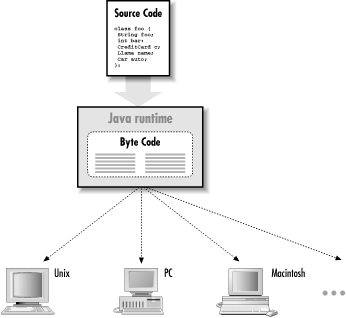Java is both a compiled and an interpreted language. Java source code is turned into simple binary instructions, much like ordinary microprocessor machine code. However, whereas C or C++ source is refined to native instructions for a particular model of processor, Java source is compiled into a universal format—instructions for a virtual machine.
Compiled Java byte-code , also called J-code, is executed by a Java runtime interpreter. The runtime system performs all the normal activities of a real processor, but it does so in a safe, virtual environment. It executes the stack-based instruction set and manages a storage heap. It creates and manipulates primitive datatypes, and loads and invokes newly referenced blocks of code. Most importantly, it does all this in accordance with a strictly defined open specification that can be implemented by anyone who wants to produce a Java-compliant virtual machine. Together, the virtual machine and language definition provide a complete specification. There are no features of Java left undefined or implementation-dependent. For example, Java specifies the sizes of all its primitive data types, rather than leave it up to each implementation.
The Java interpreter is relatively lightweight and small; it can be implemented in whatever form is desirable for a particular platform. On most systems, the interpreter is written in a fast, natively compiled language like C or C++. The interpreter can be run as a separate application, or it can be embedded in another piece of software, such as a web browser.
All of this means that Java code is implicitly portable. The same Java application byte-code can run on any platform that provides a Java runtime environment, as shown in Figure 1.1. You don’t have to produce alternative versions of your application for different platforms, and you don’t have to distribute source code to end users.
The fundamental unit of Java code is the class. As in other object-oriented languages, classes are application components that hold executable code and data. Compiled Java classes are distributed in a universal binary format that contains Java byte-code and other class information. Classes can be maintained discretely and stored in files or archives on a local system or on a network server. Classes are located and loaded dynamically at runtime, as they are needed by an application.
In addition to the platform-specific runtime system, Java has a number of fundamental classes that contain architecture-dependent methods. These native methods serve as the gateway between the Java virtual machine and the real world. They are implemented in a natively compiled language on the host platform. They provide access to resources such as the network, the windowing system, and the host filesystem. The rest of Java is written entirely in Java, and is therefore portable. This includes fundamental Java utilities like the Java compiler and Sun’s HotJava web browser, which are also Java applications and are therefore available on all Java platforms.
Historically, interpreters have been considered slow, but because the Java interpreter runs compiled byte-code, Java is a relatively fast interpreted language. More importantly, Java has also been designed so that software implementations of the runtime system can optimize their performance by compiling byte-code to native machine code on the fly. This is called just-in-time compilation. Sun claims that with just-in-time compilation, Java code can execute nearly as fast as native compiled code and maintain its transportability and security. There is only one true performance hit that compiled Java code will always suffer for the sake of security — array bounds checking. But on the other hand, some of the basic design features of Java place more information in the hands of the compiler, which allows for certain kinds of optimizations not possible in C or C++.
The latest twist in compilation techniques is a new virtual machine that Sun calls HotSpot. The problem with a traditional just-in-time compilation is that optimizing code takes time, and is extremely important for good performance on modern computer hardware. So a just-in-time compiler can produce decent results, but can never afford to take the time necessary to do a good job of optimization. HotSpot uses a trick called "adaptive compilation” to solve this problem. If you look at what programs actually spend their time doing, it turns out that they spend almost all of their time executing a relatively small part of the code again and again. The chunk of code that is executed repeatedly may only be a small percent of the total program, but its behavior determines the program’s overall performance.
To take advantage of this fact, HotSpot starts out as a normal Java byte code interpreter, but with a difference: it measures (profiles) the code as it is executing, to see what parts are being executed repeatedly. Once it knows which parts of the code are crucial to the performance, HotSpot compiles those sections—and only those sections—into true machine code. Since it only compiles a small portion of the program into machine code, it can afford to take the time necessary to optimize those portions. The rest of the program may not need to be compiled at all—just interpreted—saving memory and time.
The technology for doing this is very complex, but the idea is essentially simple: optimize the parts of the program that need to go fast, and don’t worry about the rest. Another advantage of using an adaptive compiler at runtime is that it can make novel kinds of optimizations that a static (compile time only) compiler cannot dream of.
Get Learning Java now with the O’Reilly learning platform.
O’Reilly members experience books, live events, courses curated by job role, and more from O’Reilly and nearly 200 top publishers.


